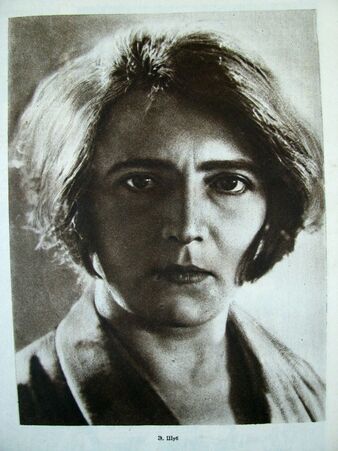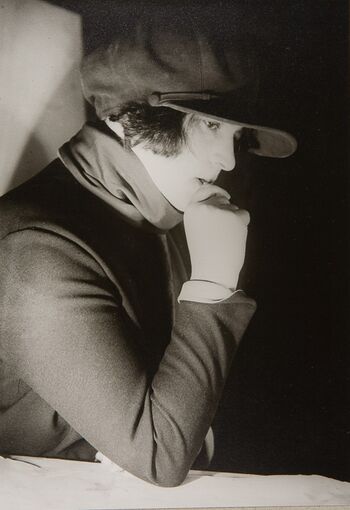Difference between revisions of "Esfir Shub"
| (18 intermediate revisions by the same user not shown) | |||
| Line 1: | Line 1: | ||
{{Infobox artist | {{Infobox artist | ||
|image = Esfir_Shub_Soviet_Screen_No_27_1927.jpg | |image = Esfir_Shub_Soviet_Screen_No_27_1927.jpg | ||
| − | |imagesize = | + | |imagesize = 338px |
|caption = Esfir Shub in ''Soviet Screen'' 27 (July 1927). | |caption = Esfir Shub in ''Soviet Screen'' 27 (July 1927). | ||
}} | }} | ||
| − | |||
| − | |||
| − | Esfir Shub like [[Dziga Vertov]] and [[ | + | [[Image:Rodchenko_Alexander_1924_Esther_Shub.jpg|thumb|350px|Portrait of Shub by [[Alexander Rodchenko]], 1924.]] |
| + | |||
| + | '''Esfir Shub''' (Эсфирь Ильинична Шуб, 1894–1959) was a pioneering Soviet filmmaker and editor in both the mainstream and documentary fields. She is best known for her trilogy of films, ''Fall of the Romanov Dynasty'' (1927), ''The Great Road'' (1927), and ''the Russia of Nicholas II and Leo Tolstoy'' (1928). | ||
| + | |||
| + | Esfir Shub like [[Dziga Vertov]] and [[Elizaveta Svilova]] developed a documentary montage film style using already existing documentary material from pre-revolutionary, tsarist times that she researched to be combined with new shots. The material was put in context through montage and inter-titles. The Fall of the Romanov Dynasty was made in 1927 on occasion of the 10th anniversary of the October Revolution. Shub became a central figure of the Soviet documentary cinema, working at the Sovkino studios since 1926 and as film director at the Central Documentary Studio from 1942-1953. [http://www.irmielin.org/nothere/esfir-shub/] | ||
Sergei Emolinsky, a constructivist critic associated with Soviet art journal, ''[[LEF]]'', praised both Shub and Vertov equally for their different attitudes towards documentary film. He explained that while, “Vertov ‘threw himself on the given material, cutting it into numerous pieces, thus subordinating it to his imagination [..] Shub regarded each piece [shot] as to a self-sufficient, autonomous entity’.” This first-hand critique of the two methods indicate that Shub’s dedication to journalistic cinematography was the catalyst for what documentary film classifies today, compilation film. [http://en.wikipedia.org/wiki/Esfir_Shub#Documentaries] | Sergei Emolinsky, a constructivist critic associated with Soviet art journal, ''[[LEF]]'', praised both Shub and Vertov equally for their different attitudes towards documentary film. He explained that while, “Vertov ‘threw himself on the given material, cutting it into numerous pieces, thus subordinating it to his imagination [..] Shub regarded each piece [shot] as to a self-sufficient, autonomous entity’.” This first-hand critique of the two methods indicate that Shub’s dedication to journalistic cinematography was the catalyst for what documentary film classifies today, compilation film. [http://en.wikipedia.org/wiki/Esfir_Shub#Documentaries] | ||
| Line 23: | Line 25: | ||
* ''The Native Country'' [Страна Родная], 1942. [http://rutracker.org/forum/viewtopic.php?t=862648] | * ''The Native Country'' [Страна Родная], 1942. [http://rutracker.org/forum/viewtopic.php?t=862648] | ||
* ''On the Other Side of the Araks'', 1946. | * ''On the Other Side of the Araks'', 1946. | ||
| + | |||
| + | ==Writings== | ||
| + | * "Rabota montazhnits" [Работа монтажниц], ''Sovetsky ekran'', 1928. {{ru}} | ||
| + | ** [http://www.apparatusjournal.net/index.php/apparatus/article/view/125/304 "The Work of ''Montazhnitsy''"], intro. & trans. Alla Gadassik, ''Apparatus'' 6: "Women at the Editing Table: Revising Soviet Film History of the 1920s and 1930s", eds. Adelheid Heftberger and Karen Pearlman, Berlin, 2018. {{en}} | ||
| + | |||
| + | ==Film== | ||
| + | * ''Esfir'', dir. Cynthia Madansky, 2020, 16mm. Contemporary interpretation of an unrealized script titled ''Women'', written by Esfir Shub. [https://karagarga.in/details.php?id=322751] | ||
==Literature== | ==Literature== | ||
| Line 28: | Line 37: | ||
* "'...Болезнь моя иного порядка'. Письма Алексея Гана Эсфири Шуб" ['...My ilness is of another mode'. Letters from Alexei Gan to Esfir Shub], ''Kinovedcheskie zapiski'' 49 [Киноведческие записки] (2000), Moscow, pp 222-228. Gan's letter to Esfir Shub, disclosing their differences concerning development of domestic cinema of the 1920s and presenting hard attempts at self identification of one of the founders of Constuctivism under post-revolutionary regime. [http://www.kinozapiski.ru/ru/article/sendvalues/372/] {{ru}} | * "'...Болезнь моя иного порядка'. Письма Алексея Гана Эсфири Шуб" ['...My ilness is of another mode'. Letters from Alexei Gan to Esfir Shub], ''Kinovedcheskie zapiski'' 49 [Киноведческие записки] (2000), Moscow, pp 222-228. Gan's letter to Esfir Shub, disclosing their differences concerning development of domestic cinema of the 1920s and presenting hard attempts at self identification of one of the founders of Constuctivism under post-revolutionary regime. [http://www.kinozapiski.ru/ru/article/sendvalues/372/] {{ru}} | ||
* "Письмо Эсфири Шуб Алексею Гану" [A letter from Esfir Shub to Alexei Gan], ''Kinovedcheskie zapiski'' 49 [Киноведческие записки] (2000), Moscow, pp 229-230. The last letter from Esfir Shub to Alexei Gan. [http://www.kinozapiski.ru/ru/article/sendvalues/373/] {{ru}} | * "Письмо Эсфири Шуб Алексею Гану" [A letter from Esfir Shub to Alexei Gan], ''Kinovedcheskie zapiski'' 49 [Киноведческие записки] (2000), Moscow, pp 229-230. The last letter from Esfir Shub to Alexei Gan. [http://www.kinozapiski.ru/ru/article/sendvalues/373/] {{ru}} | ||
| − | * Joshua Malitsky, "A Certain Explicitness: Objectivity, History, and the Documentary Self", ''Cinema Journal'' 50:3 (Spring 2011), pp 26-44; new version as "Esfir Shub, Factography, and the New Documentary Historiography", ch. 5 in Malitsky, ''[http:// | + | * Joshua Malitsky, "A Certain Explicitness: Objectivity, History, and the Documentary Self", ''Cinema Journal'' 50:3 (Spring 2011), pp 26-44; new version as "Esfir Shub, Factography, and the New Documentary Historiography", ch. 5 in Malitsky, ''[http://libgen.rs/book/index.php?md5=395271008b1ec99ae5c7fb36eb5c0d18 Post-Revolution Nonfiction Film: Building the Soviet and Cuban Nations]'', Indiana University Press, 2013. [http://books.google.com/books?id=Rnp6YtQgBB8C&pg=PA155] {{en}} |
* Joshua Malitsky, [http://academia.edu/6188339 "Ideologies in Fact: Still and Moving-Image Documentary in the Soviet Union, 1927-1932"], ''Journal of Linguistic Anthropology'' 20:2 (2010), pp 352-371. {{en}} | * Joshua Malitsky, [http://academia.edu/6188339 "Ideologies in Fact: Still and Moving-Image Documentary in the Soviet Union, 1927-1932"], ''Journal of Linguistic Anthropology'' 20:2 (2010), pp 352-371. {{en}} | ||
| + | * Catherine Walworth, "Esfir Shub: 'The Magician of the Editing Table'", ch 4 in Walworth, ''[http://library.memoryoftheworld.org/#/book/edf30eed-6232-4a1c-ad6a-da30382b4073 Soviet Salvage: Imperial Debris, Revolutionary Reuse, and Russian Constructivism]'', Pennsylvania State University Press, 2017, pp 129-159. {{en}} | ||
| + | * Lilya Kaganovsky, "The Materiality of Sound: Dziga Vertov's ''Enthusiasm'' and Esfir Shub's ''K.Sh.E.''", ch 2 in Kaganovsky, ''[http://library.memoryoftheworld.org/#/book/f98dc3fb-f33d-43b3-bb1f-19cd17a93ad0 The Voice of Technology: Soviet Cinema's Transition to Sound, 1928-1935]'', Indiana University Press, 2018, pp 70-107. {{en}} | ||
| + | * Lilya Kaganovsky, [http://www.apparatusjournal.net/index.php/apparatus/article/view/114/303 "Film Editing as Women's Work: Ėsfir’ Shub, Elizaveta Svilova, and the Culture of Soviet Montage"], ''Apparatus'' 6: "Women at the Editing Table: Revising Soviet Film History of the 1920s and 1930s", eds. Adelheid Heftberger and Karen Pearlman, Berlin, 2018. {{en}} | ||
| + | * Ilana Shub Sharp, ''Esfir Shub: Pioneer of Documentary Filmmaking'', Bloomsbury, 2022, 344 pp. [https://www.bloomsbury.com/uk/esfir-shub-9781501376511/ Publisher]. {{en}} | ||
* [http://www.lib.berkeley.edu/MRC/sovietfilmbib.html#shub More] | * [http://www.lib.berkeley.edu/MRC/sovietfilmbib.html#shub More] | ||
==Links== | ==Links== | ||
| − | * [ | + | * [https://wfpp.columbia.edu/pioneer/ccp-esfir-shub/ Shub on Women Film Pioneers Project] |
| − | * [http://jwa.org/encyclopedia/article/shub-esfir Shub | + | * [http://jwa.org/encyclopedia/article/shub-esfir Shub in Jewish Women's Archive] |
| − | * [http://russiancinema.ru/names/name1243/ Shub | + | * [http://russiancinema.ru/names/name1243/ Shub on RussianCinema.ru] {{ru}} |
| − | * [http://en.wikipedia.org/wiki/Esfir_Shub | + | * [http://en.wikipedia.org/wiki/Esfir_Shub Wikipedia] |
| − | [[ | + | [[Series:Film]] [[Series:Experimental film]] |
| + | {{DEFAULTSORT:Shub, Esfir}} | ||
Latest revision as of 10:07, 20 May 2023
 Esfir Shub in Soviet Screen 27 (July 1927). |

Esfir Shub (Эсфирь Ильинична Шуб, 1894–1959) was a pioneering Soviet filmmaker and editor in both the mainstream and documentary fields. She is best known for her trilogy of films, Fall of the Romanov Dynasty (1927), The Great Road (1927), and the Russia of Nicholas II and Leo Tolstoy (1928).
Esfir Shub like Dziga Vertov and Elizaveta Svilova developed a documentary montage film style using already existing documentary material from pre-revolutionary, tsarist times that she researched to be combined with new shots. The material was put in context through montage and inter-titles. The Fall of the Romanov Dynasty was made in 1927 on occasion of the 10th anniversary of the October Revolution. Shub became a central figure of the Soviet documentary cinema, working at the Sovkino studios since 1926 and as film director at the Central Documentary Studio from 1942-1953. [1]
Sergei Emolinsky, a constructivist critic associated with Soviet art journal, LEF, praised both Shub and Vertov equally for their different attitudes towards documentary film. He explained that while, “Vertov ‘threw himself on the given material, cutting it into numerous pieces, thus subordinating it to his imagination [..] Shub regarded each piece [shot] as to a self-sufficient, autonomous entity’.” This first-hand critique of the two methods indicate that Shub’s dedication to journalistic cinematography was the catalyst for what documentary film classifies today, compilation film. [2]
Shub was married to Aleksei Gan.
Contents
Filmography[edit]
- The Fall of the Romanov Dynasty, dir. Esfir Schub, 1927.
- Prostitutka, dir. Oleg Frelikh, ed. Esfir Shub, 77 min, 1927.
- The Great Road, 1927.
- The Russia of Nicholas II and Lev Tolstoi, 1928.
- Today, 1930.
- Komsomol: Patron of Electrification [Комсомол - шеф электрификации], dir. Esfir Shub, 1932. [3] [4]
- Spain [Испания], 1939. [5]
- The Native Country [Страна Родная], 1942. [6]
- On the Other Side of the Araks, 1946.
Writings[edit]
- "Rabota montazhnits" [Работа монтажниц], Sovetsky ekran, 1928. (Russian)
- "The Work of Montazhnitsy", intro. & trans. Alla Gadassik, Apparatus 6: "Women at the Editing Table: Revising Soviet Film History of the 1920s and 1930s", eds. Adelheid Heftberger and Karen Pearlman, Berlin, 2018. (English)
Film[edit]
- Esfir, dir. Cynthia Madansky, 2020, 16mm. Contemporary interpretation of an unrealized script titled Women, written by Esfir Shub. [7]
Literature[edit]
- A.Konopleva-Shub (А.Б.Коноплева), "Алексей Михайлович Ган" [Alexei Mikhailovich Gan], Kinovedcheskie zapiski [Киноведческие записки] 49 (2000), Moscow, pp 212-221. Memoirs of Esfir Shub’s daughter about her step-father. (Russian)
- "'...Болезнь моя иного порядка'. Письма Алексея Гана Эсфири Шуб" ['...My ilness is of another mode'. Letters from Alexei Gan to Esfir Shub], Kinovedcheskie zapiski 49 [Киноведческие записки] (2000), Moscow, pp 222-228. Gan's letter to Esfir Shub, disclosing their differences concerning development of domestic cinema of the 1920s and presenting hard attempts at self identification of one of the founders of Constuctivism under post-revolutionary regime. [8] (Russian)
- "Письмо Эсфири Шуб Алексею Гану" [A letter from Esfir Shub to Alexei Gan], Kinovedcheskie zapiski 49 [Киноведческие записки] (2000), Moscow, pp 229-230. The last letter from Esfir Shub to Alexei Gan. [9] (Russian)
- Joshua Malitsky, "A Certain Explicitness: Objectivity, History, and the Documentary Self", Cinema Journal 50:3 (Spring 2011), pp 26-44; new version as "Esfir Shub, Factography, and the New Documentary Historiography", ch. 5 in Malitsky, Post-Revolution Nonfiction Film: Building the Soviet and Cuban Nations, Indiana University Press, 2013. [10] (English)
- Joshua Malitsky, "Ideologies in Fact: Still and Moving-Image Documentary in the Soviet Union, 1927-1932", Journal of Linguistic Anthropology 20:2 (2010), pp 352-371. (English)
- Catherine Walworth, "Esfir Shub: 'The Magician of the Editing Table'", ch 4 in Walworth, Soviet Salvage: Imperial Debris, Revolutionary Reuse, and Russian Constructivism, Pennsylvania State University Press, 2017, pp 129-159. (English)
- Lilya Kaganovsky, "The Materiality of Sound: Dziga Vertov's Enthusiasm and Esfir Shub's K.Sh.E.", ch 2 in Kaganovsky, The Voice of Technology: Soviet Cinema's Transition to Sound, 1928-1935, Indiana University Press, 2018, pp 70-107. (English)
- Lilya Kaganovsky, "Film Editing as Women's Work: Ėsfir’ Shub, Elizaveta Svilova, and the Culture of Soviet Montage", Apparatus 6: "Women at the Editing Table: Revising Soviet Film History of the 1920s and 1930s", eds. Adelheid Heftberger and Karen Pearlman, Berlin, 2018. (English)
- Ilana Shub Sharp, Esfir Shub: Pioneer of Documentary Filmmaking, Bloomsbury, 2022, 344 pp. Publisher. (English)
- More